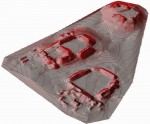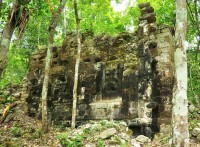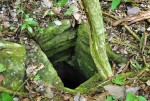 Archaeologists have discovered two lost Mayan cities in the jungle of the Calakmul Biosphere Reserve on the southeastern tip of Mexico’s Yucatán peninsula. The cities have been named Tamchén and Lagunita. Initial exploration indicates both cities were at their peak in the Late and Terminal Classic period (600-1000 AD), the early part of which saw the apogee of the dominant regional power: the kingdom of Calakmul, ruled by the mighty Snake dynasty.
Archaeologists have discovered two lost Mayan cities in the jungle of the Calakmul Biosphere Reserve on the southeastern tip of Mexico’s Yucatán peninsula. The cities have been named Tamchén and Lagunita. Initial exploration indicates both cities were at their peak in the Late and Terminal Classic period (600-1000 AD), the early part of which saw the apogee of the dominant regional power: the kingdom of Calakmul, ruled by the mighty Snake dynasty.
 Led by Ivan Sprajc of the Scientific Research Centre of the Slovenian Academy of Sciences and Arts, for the past two months the expedition has been macheteing its way through the eastern part of the state of Campeche, a vast area that is thought to be rich in Mayan archaeology but has barely been explored because of how inaccessible it is. This team has the advantage of aerial photography and a geodesist as well as local guides.
Led by Ivan Sprajc of the Scientific Research Centre of the Slovenian Academy of Sciences and Arts, for the past two months the expedition has been macheteing its way through the eastern part of the state of Campeche, a vast area that is thought to be rich in Mayan archaeology but has barely been explored because of how inaccessible it is. This team has the advantage of aerial photography and a geodesist as well as local guides.
 Lagunita was actually found once before, by American Mayanist, epigrapher and explorer Eric von Euw in 1970. He drew sketches of a several monuments, most strikingly a façade depicting the open maw of a zoomorphic monster. He never published his drawings nor noted the location of the find, but his sketches are kept in Harvard University’s Peabody Museum of Archaeology and Ethnology and Maya scholar Karl Herbert Mayer made them available to Sprajc.
Lagunita was actually found once before, by American Mayanist, epigrapher and explorer Eric von Euw in 1970. He drew sketches of a several monuments, most strikingly a façade depicting the open maw of a zoomorphic monster. He never published his drawings nor noted the location of the find, but his sketches are kept in Harvard University’s Peabody Museum of Archaeology and Ethnology and Maya scholar Karl Herbert Mayer made them available to Sprajc.
 It was that dramatic façade that identified the site as Euw’s Lagunita. Its open mouth represents the entrance to the underworld and the creature represents a Maya fertility deity. Other structures were found: a Maya ball game court, a pyramid 65 feet high, massive palaces arranged around four plazas, three altars, 10 trails connecting the buildings and altars, and 10 stelae. There are inscriptions on the altars and stelae, and a key section of stela two has already been translated by Octavio Esparza Olguin, an epigrapher from the National Autonomous University of Mexico. For our convenience, it’s a precise date — November 29th, 711 A.D. — and a signature of the “lord of 4 k’atuns” (a k’atun is a 20-year calendar cycle). Olguin notes:
It was that dramatic façade that identified the site as Euw’s Lagunita. Its open mouth represents the entrance to the underworld and the creature represents a Maya fertility deity. Other structures were found: a Maya ball game court, a pyramid 65 feet high, massive palaces arranged around four plazas, three altars, 10 trails connecting the buildings and altars, and 10 stelae. There are inscriptions on the altars and stelae, and a key section of stela two has already been translated by Octavio Esparza Olguin, an epigrapher from the National Autonomous University of Mexico. For our convenience, it’s a precise date — November 29th, 711 A.D. — and a signature of the “lord of 4 k’atuns” (a k’atun is a 20-year calendar cycle). Olguin notes:
“To judge by both architectural volumes and monuments with inscriptions, Lagunita must have been the seat of a relatively powerful polity, though the nature of its relationship with the larger Chactún, lying some 10 km to the north, remains unclear.” The importance of Lagunita is further attested by the great density of residential mounds, terraces, albarradas (low dry walls) and other settlement remains in the surrounding area.
 The second site, Tamchén, has much in common with its neighbor four miles to the southeast. It too has large buildings arranged around plazas, a pyramid temple, a courtyard with three temples on each side, altars and stelae. It’s significantly older, however, dating to the Late Preclassic (300 B.C. – 250 A.D.). It also has another unusual feature: more than 30 chultuns, underground wells built to collect rainwater. Chultuns are common in Maya cities, but the number at Tamchén is far greater than have been discovered anywhere else, and they are remarkably deep as well, some approaching 45 feet in depth. We can’t know if this proliferation of chultuns is unique to Tamchén or if other Maya cities in the region have similar structures until the area is more fully explored.
The second site, Tamchén, has much in common with its neighbor four miles to the southeast. It too has large buildings arranged around plazas, a pyramid temple, a courtyard with three temples on each side, altars and stelae. It’s significantly older, however, dating to the Late Preclassic (300 B.C. – 250 A.D.). It also has another unusual feature: more than 30 chultuns, underground wells built to collect rainwater. Chultuns are common in Maya cities, but the number at Tamchén is far greater than have been discovered anywhere else, and they are remarkably deep as well, some approaching 45 feet in depth. We can’t know if this proliferation of chultuns is unique to Tamchén or if other Maya cities in the region have similar structures until the area is more fully explored.
 There are many intriguing aspects to these cities that may open a new window into Maya history.
There are many intriguing aspects to these cities that may open a new window into Maya history.
The zoomorphic façade at Lagunita does not come as a surprise, considering that Becán, the largest site in the Río Bec zone, is only 15 km away. What has not been expected, however, is the presence of so many pyramid temples and monuments with inscriptions, which are rare in the Río Bec región. Both Tamchén and Lagunita appear to have been largely abandoned around A.D. 1000, sharing the fate of other lowland Maya polities, but a few stelae were modified some time after they had been originally erected, and Postclassic offerings were found at others. These facts obviously reflect continuities and ruptures in cultural traditions, but their significance for understanding political geography and history of the region is yet to be explained.
Particularly interesting are various elements that have not been known elsewhere in the Maya area. Two altars of Lagunita have a curious nail-head shape. The third one is rectangular and has a series of Ajaw glyphs on its sides, with coefficients evidently referring to successive k’atun (20-year period) endings; such records are common in codices, but not on stone monuments. Whereas hieroglyphic texts normally appear in an even number of columns, the inscription on Stela 2 of Lagunita has three, and the Long Count date is incomplete.